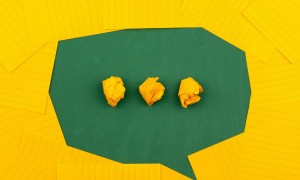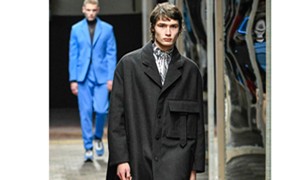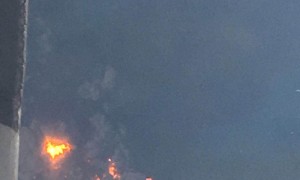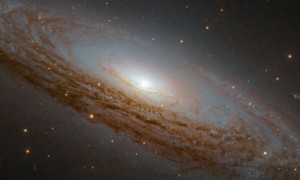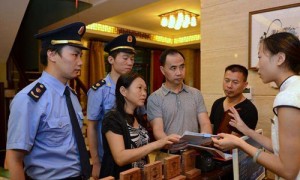Part 3 A Tour to Paris II 巴黎旅游胜地介绍(下)
The Arc de Triomphe du Carrousel 凯旋门
The Arc de Triomphe du Carrousel was built between 1806 and 1808 by Napoleon I follow ing the model of the Arc of Constantine in Rome. The two arches built by Napoleon - Arc de Triomphe du Carrousel and the Arc de Triomphe at Etoile, were to commemorate his victories, and the grand army who had won them. The bronze horses on top of the Arc de Triomphe du Carrousel were taken from Saint-Marc of Venice. These were later returned after WWII.
高45米的凯旋门,是当年拿破仑为纪念法国大军战胜奥俄联军而建造的,前后经过三十年,一八六三年建成。在这雄伟的建筑物下就是无名英雄纪念碑从凯旋门可以看到迷人的香谢丽舍大道和十二条以凯旋门为中心,向四面八方伸展的放射形大道。
Versailles 凡尔赛宫
Situated several km S-W of Paris, Versailles, at the time of Louis XIII was no more than a modest hunting lodge. The creation of the great castle was due to Louis XIV who abandoned the Louvre to build a royal palace. The architects Hardouin-Mansart and Le Notre managed the works for a long time. In 1789, the royal family finally returned to Paris. In 1837, Louis-Philippe decided to convert it as the museum of French History. Nowadays, the castle has been restored to be as beautiful as in the past.
位于巴黎西南郊约20公里处的凡尔赛宫,由路易十四建造,以其特有的建筑群闻名于世,包括城堡、花园、教堂及镜殿等等。它是欧洲最繁华的一座宫殿,气势磅礴,布局严密。它的外观宏伟、壮观,内部陈设及装璜更富于艺术魅力。凡尔赛宫包括100万平方米的园林,700多个房间厅室和一所可容纳1200名观众的剧院。正宫前面是一座风格独特的法兰西式的大花园,园内树木花草,郁郁葱葱,如茵的草地,绚丽的花坛,景色优美。此外,1400多个不息喷涌的喷泉,纷呈异彩,使人流连忘返。
The Place de la Concorde 协和广场
The Place de la Concorde, which is the largest place in Paris, is situated along the Seine and separates the Tuilerie Gardens from the beginning of the Champs Elysées. It is in the 8th arrondissement, or district, of the city.
Jacques Ange Gabriel, Louis XV's architect, began construction in 1754 and completed it in 1763. It was thus called the Place Louis XV. The place was constructed to hold an equestrian statue of Louis XV that the city of Paris commissioned in 1748 from Bouchardon to offer to the king.
The place formed an octagon bordered by large moats that no longer exist. In contrast to older places that were closed, la Place de la Concorde, largely open, served as an intersection as well as a decoration.
The equestrian statue marks the intersection of two principal axis: the East-West axis from the perspective of the Tuilerie Gardens and the Champs Elysées, the North-South axis from the perspective of la rue Royale and the bridge created in alignment. with respect to urban accomplishments, it is the greatest achievement of the Enlightenment in the capital.
协和广场建成于1775年,它是为歌颂法国路易十五世而建的。耸立于广场中心的纪念碑是1831年埃及赠送给法国的。协和广场最美的莫过于它的夜景:古色古香的路灯,燃着菊色的光泽,融入香谢丽舍大道的灯,一直注入凯旋门的不灭之火;是花都的夜光河,如此柔和,似乎有意尽可能的照亮广场的夜。
The Avenue des Champs-Elysées 香谢丽舍大道
The Avenue des Champs-Elysées is probably the most famous avenue in the world. this impressive promenade stretches from the Place the la Concorde to the Place Charles de Gaulle, the site of the Arc de Triomphe.
At its western end it is bordered by cinemas, theaters, cafés and luxury shops. Near the Place de la Concorde, the street is bordered by the Jardins des Champs-Elysées, beautifully arranged gardens with fountains and some grand buildings including the Grand and Petit Palais at the southern side and the Elysée at its northern side. The latter has been the residence of the French Presidents since 1873.
The Champs-Elysées is used for all the major celebrations. This is where Parisians celebrate New Year's Eve and where the military parades are held on the 14th of July. Historic national events, like the Liberation at the end of the second World War or the victory in the World Cup football were also celebrated on this wide avenue.
香谢丽舍大道是巴黎最漂亮的一条大道,它西接凯旋门,东连协和广场,长约2.5公里,中间能容纳10线行车,大道两旁是繁华热闹的商业街,有很多大百货公司和银行,游人如鲫。
入夜时分,凯旋门上方由射灯照射出蓝、白、红三色光柱,与大道上灿烂的灯光交相辉映,非常美丽。它是世界著名的商业区,一流的服装店、香水店、红磨坊等都集中在这里。每年的国庆,都是在这条大道上庆祝。
The H?tel des Invalides 荣军院
The complex known as the H?tel des Invalides was founded in 1671 by Louis XIV, the Sun King. He wanted to provide acco mmodation for disabled and impoverished war veterans. Originally only a number of barracks were planned, but king Louis XIV chose a design by the architect Liberal Bruant which consisted of a large impressive building with a royal courtyard and church.
The front facade facing the Seine river is 196 meter long. The whole complex features 15 courtyards, the largest being the cour d'honneur (court of honor). This courtyard was used for military parades.
The church is connected directly with the Royal chapel, better known as the D?me des Invalides. This church, with a 107 meters high dome was for exclusive use of the royal family.
Construction of the dome was completed in 1708. Plans to bury the remains of the Royal Family were set aside after the death of king Louis XIV, and in 1840 Louis-Philippe repatriated the remains of the Emperor Napoleon from st. Helena, where he was buried after his death 19 years earlier.
荣军院建筑风格古典美观, 政治地位显赫。尽管历史上它先后被当作收容所、医院、军营和修道院, 但是他一直都保留着建筑和气氛上的和谐。作为法兰西馆藏最丰富的军事博物馆之一, 令人肃然起敬;常有人来此凭吊英雄, 感伤古今。拿破仑的墓葬就设在这里。
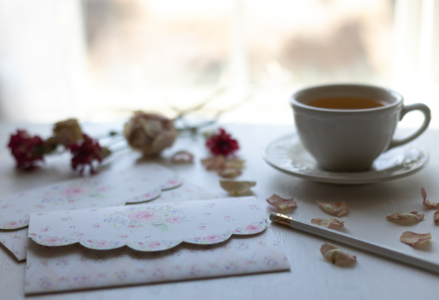
the Musée d'Orsay 奥赛博物馆
Spectacularly housed in a former railway station built in 1900, the Musée d'Orsay was reinaugurated in its present form in 1986. Inside is a trove of artistic treasures produced between 1848 and 1914, including highly regarded Impressionist and Post-impressionist works.
Most of their paintings and sculptures are found on the ground floor and the skylight-lit upper level, while the middle level has some magnificent rooms showcasing the Art-Nouveau moveme nt.
Nearby, the Musée Rodin displays the lively bronze and marble sculptures by Camille Claudel and Auguste Rodin, including casts of some of Rodin's most celebrated works. There's a shady sculpture garden out the back, one of Paris' treasured islands of calm.
奥赛宫美术馆原来是奥赛火车站,1900年为万国博览会在巴黎举行而建。奥赛火车站也是巴黎最早实现电气化的火车站。1977年法国政府决定把它改建为博物馆,内部改造由意大利建筑师盖·奥朗第完成。展品主要来自卢浮宫原有收藏品,作品年代为1848-1914年之间,可以说是卢浮宫的延续,法国印象派大师的作品以及梵高的作品都有专门的展室。
Part 4 They're Leaving Paris 他们要离开巴黎了
Dialogue script 1 对话原文 1
(After the catacombs; at Notre Dame)
Tina: Now this church seems a lot older. Excuse me, would you take a picture?
Man: You can't use a flash in here.
Tina: That's OK. Just see if you can get both of us in.
Man: Do you want anything special in the background?
Tina: Um...how about that big organ?
Man: That should be simple. (Presses button) Did the picture take?
Tina: (Looks at her camera) Hmm, I don't think so. Could you snap one more to be sure?
讲解:
1. 对话中Tina和Mark在参观完巴黎圣母院,想拍照留念。巴黎圣母院就是Notre Dame,是法国歌特式教堂的经典之作,年代也比较久远了。在教堂里面,拍照不准使用闪光灯,flash就是“闪光灯”的意思。比如说,This cameral has a built-in flash. 这台照相机有内置闪光灯。I'll need flash for this shot; the light isn't good enough in here. 拍这张照片需要闪光灯;这里光线不太好。
2. 不能用闪光灯也没有关系,只要把人照进去就行了。帮他们拍照的人还问需不需要什么特别的背景,Tina建议把后面的大风琴作为背景。嗯,拍起来挺简单的,Did the picture take?就是问“照上了吗?照好了吗?”。Tina检查了一下相机,好像没有照上。
3. 所以她请那个人再拍一张,以防万一。snap在这里是“很快地给某人或某物拍照”的意思,比如说,I snapped you sunbathing on the beach. 我给你拍了一张海滩日光浴的照片。
Dialogue script 2 对话原文 2
(The two are about to enter the Louvre)
Mark: I've never been so tired in my whole life. Maybe I'll just stay outside.
Tina: In this hot weather? Besides, you'll miss the Mona Lisa.
Mark: True. Alright. I'm going. But promise me we won't have to walk through this whole museum.
Tina: Well, maybe just the paintings and the sculptures. And, oh, yeah, the furniture collection.
Mark: We're going to be here forever.
Tina: (At the counter) Oh darn! The furniture collection is closed tonight.
Mark: (To himself) Somebody up there loves me.
讲解:
1. 对话中,Tina 和Mark正准备进卢浮宫参观,Mark觉得很累,所以不想进去了,呆在外面等Tina就好了。卢浮宫是the Louvre,位于巴黎市中心塞纳河右岸,是世界三大博物馆之一,收藏品种达三十万件,达芬奇的巨作Mona Lisa 是卢浮宫三宝之一。 另外两个就是维那斯和胜利女神雕像。
2. Mark说他这一辈子都没有这么累过,连卢浮宫都不想进了,只想在外面休息。这样也太可惜了。Tina劝他说,外面天气很热,况且如果不进去的话就会错过观赏名画Mona Lisa的机会了。这里的besides是副词,表示“此外,而且”。
3. miss这里可不是表示“想念”,而是表示“错过”,比如说,I missed the first part of the movie. 我没看到电影的开头。He missed the 8.30 train. 他没赶上8点30分的火车。这里有一个习语大家要记住,就是miss the boat/bus,意思是“错过机会”,比如说,If we don't offer a good price for the house now, we'll probably miss the boat altogether. 这所房子如果我们现在不给个高价的话,可能就要失去机会了。
4. Mark也觉得不去欣赏Mona Lisa是挺可惜的。但是他让Tina承诺不用逛完整个博物馆,他的体力会吃不消。Tina说他们也许只看看绘画、雕刻就好了,还有家具展。Mark一听就要晕倒了,We're going to be here forever.我们要永远待在这里了。但是Tina却发现家具展今天晚上就关闭了,darn,在口语中表示“ 烦恼,不耐烦”等情绪,跟damn差不多。比如说,Darn it! She beat me again! 该死!她又赢了我。
5. Mark听见这个消息就高兴了,自言自语地说,Somebody up there loves me. 上帝爱我!somebody up there是指“上面的人”,那么有谁会在上面呢?当然是上帝了!所以Somebody up there loves me. 这句话就等于God loves me! 上帝保佑我!当幸运之神眷顾你的时候,你就可以说这句话。我们用一个对话来作例子,---How did you make so much money? --- Someday up there loves me. ---你怎么赚了这么多钱?---因为上帝眷顾我。当你逃过一劫,或者是好事情降临,为了表达心中的感激,也可以这么说,--- Someday up there loves me. ---I think you are successful because you work really hard. ---上帝爱我。---不,我认为你会成功是因为你确实很努力。
Dialogue script 3 对话原文 3
(Last spot of the night, the Eiffel Tower)
Mark: I can't believe we are really here.
Tina: Here's your ticket. Should we walk up? Just joking. There are elevators.
Mark: (Later, standing at the top) Brrr, it is freezing up there.
Tina: The wind feels like knives stabbing my skin.
Mark: Do you feel that? Oh my, I think it's an earthquake!
Tina: Mark, those are the vibrations from the wind. Think how high up we are.
Mark: Wow, that's strong. I'm an ice cube now. Gotta go back inside.
Tina: Me, too. But what an amazing view!
讲解:
1. 现在Tina和Mark两个人来到了埃菲尔铁塔,他们都不敢相信自己真的见到了著名的埃菲尔铁塔,他们还买了登上铁塔的票。Tina知道Mark怕累,还开玩笑地说,我们要不要走上去?看到Mark脸色变了,赶紧说Just joking. 这句话完整了就是I was just joking.
2. 通往塔顶可以搭乘电梯,就是elevator。那么我们平常在商场看到的滚梯的英文说法是什么?可不是elevator,而是escalator,这两个词区分开。现在他们已经到了塔顶,由于埃菲尔铁塔很高,所以塔顶的温度很低,简直可以用寒风刺骨来形容,就是freezing,就像刀子刮在脸上一样。
3. 这时Mark好像感觉到有地震,还问Tina感觉到了没有,Tina提醒Mark说,这只是风吹铁塔造成的摇晃,因为他们在很高的地方。vibrations的意思是“震动,颤动”,比如说,Even at full speed, the ship's engines cause very little vibration. 这条船即使全速前进,发动机的震动也很小。看来在塔顶的风真是挺大的。
4. Mark已经开始抱怨了,风太大了,快把他冻成冰棍了,得赶快进去,gotta 就是have gotta do something 的缩写。Tina也感觉很冷了,不过她还真有点舍不得在塔顶看到的美妙景色。埃菲尔铁塔是他们在巴黎旅游的最后一站了。
Dialogue script 4 对话原文 4
Tina: Sho, sho! Wake up! We slept through our alarm.
Mark: Wha...what time is it?
Tina: It's almost eleven o'clock. And I'm taking control of what we do today. Time to hit the shops!
Mark: OK. Do you know where you want to go?
Tina: Our guide book says Champs Elysees has everything. Armani, Chanel, Versace, Cartier, you name it.
(at the Galeries Lafayette)
Tina: Mark, this place is beautiful! It looks like it's covered in gold.
Mark: I thought you would like it. This area is almost a hundred years old.
Tina: I'm going to take a picture of the two of us.
Mark: Don't want to get someone else to take that for us?
Tina: And waste valuable shopping time?
Mark: Hah! OK, I'll tell you what. You go, and I'll get us some of the tourist shopping discount cards I heard about.
Tina: Discount? I think you just said my magic word! I'm off!
讲解:
1. 在巴黎的最后一天,他们会干些什么呢?当然是去Tina盼望已久的购物中心了。巴黎是世界时尚之都之一,当然也是购物的天堂了。Tina已经迫不及待了,一大早就把Mark叫醒,sleep through这个词组表示“不被...吵醒,继续睡。sleep through our alarm是指“睡到超过闹钟响的时间”,也就是“睡过头了”。
2. 现在已经是中午11点多了,Tina说今天还是由她来决定行程,血拼的时间到了。血拼这个词大家都知道了,就是“大肆购物”的意思,也算是新出现的一个词吧,我估计就是根据shopping这个词译过来的,音译加意译。take control of something,这个词组的意思是“控制,掌控”。
3. Time to hit the shops. 该去商店了,血拼的时间到了。这里的hit是一个不太正式的用法,在口语中经常出现,表示“到达某地,在某地”,比如,When does the new show hit town? 这部新戏什么时候在城里演出?还有我们大家比较熟悉的,It's time to hit the road. 该出发了,该上路了。It's time to hit the sack. 该睡觉了。都是在口语当中经常出现的说法。
4. 那么应该去哪里购物呢?Tina在导游手册上看到在香谢丽舍大街上应有尽有,很多世界名牌商品都在这里汇集。香谢丽舍大街就是Champs Elysees,从协和广场到凯旋门全长1.8公里,是横贯巴黎最有特色、最繁华的街道之一。Tina还提到了很多名牌,比如说有意大利顶级服装品牌,Armani,法国品牌 Channel,意大利品牌Versace等等。
5. 在这里你想买的东西都会买到,Tina说You name it. 这个句子是用来举例子用的,表示“等等,之类”的意思,以前我们也提到过。这里呢要把You name it. 和Just name a few.这两个句子比较一下。虽然两个句子的意思相同,但是You name it.却可以放在句首使用。比如说,---Where have you been in Asia?---You name it, I've been there.---你去过亚洲哪些地方?---你随便说个地方,我都去过。还有,---Where have you been in China?---Shanhai, Bejing, Nanjing, to just name a few places. ---你去过中国哪些地方?---上海、北京、南京,只是随便举几个例子。
6. 现在他们已经来到了Galeries Lafayette,老佛爷百货,是法国有名的百货公司。Tina觉得这个地方真是漂亮极了,看起来像是镶上了黄金一样。而且这个地方几乎有一百年的历史了。
7. Tina还想在这里拍照留念,Mark建议Tina自己去拍照,他去给Tina拿他曾经听说过的游客打折卡,就是the tourist shopping discount cards。Tina听了很高兴,I think you just said my magic word! 你真是说到我心坎里去了。magic word原来的意思是“咒语”,这里是指“某个人最喜欢听到的话”。
8. Tina高兴地跑去照相了,I'm off! 我这就去!I'm off!是一句很常见的口语,有“走了,出发啦”的意思,不管是用在迫不及待要出去血拼,还是要归心似箭地下班、放学,I'm off!都是一句很常用的话。比如说,---I'm off! ---See you tomorrow! ---我走了!---明天见!还有,---When are you coming back to work? ---I'm off till next week. ---你什么时候回来工作?---我要到下星期才会回来。



